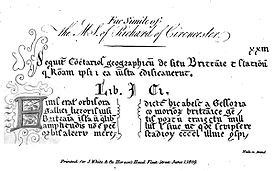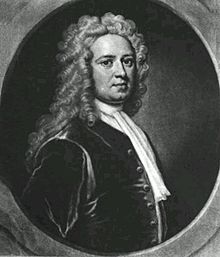- Charles Bertram
-
Charles Julius Bertram Born 1723
London, EnglandDied January 8, 1765 Occupation Writer Notable work(s) De Situ Britanniae Charles Bertram (1723 – 1765) was the author of the forged manuscript De Situ Britanniae ("The Description of Britain"), a spurious history that was highly influential in the reconstruction of the history of Roman Britain for over a century. It had a similar impact on the explanation of Scottish history over the same period of time. He was otherwise a little-known writer, and his authorship of the forgery is his only modern notability. Bertram's motives are still unknown, as he never tried to profit directly from the forgery. For the remainder of his life, his notability was merely that he had found a valuable "lost" history of Britain and had made its contents public.
Contents
Early life
Charles Bertram was the son of an English silk dyer who migrated to Copenhagen among the retinue of Princess Louisa, daughter of George II who married Crown Prince Frederick of Denmark in 1743 (he would become King three years later). The father established himself as a hosier, and Charles seemed to have benefited from the warm reception that Louisa and her retinue had received from the Danes. In 1747 Charles' petition to the Consistorium for entry to the University of Copenhagen was granted, even though it should not have been granted, because he belonged to the Anglican Church.[1] He became a friend and protege of Hans Gramm, privy-counselor and librarian to the King of Denmark, a relationship that would be important during subsequent events. In 1748 Bertram petitioned the king to be permitted to give public lectures on the English language, and he became a teacher of English in the Royal Marine Academy at Copenhagen (some accounts say he was a professor, rather than a tutor of students; if so, that would be some years later, as he was a new undergraduate in 1747).
The forgery
For a discussion of the forged document and its impact, see De Situ BritanniaeBertram wrote a letter to the celebrated antiquarian William Stukeley in 1746, saying he had access to an old manuscript written by a medieval English monk named Richard of Westminster, and which contained much information on Roman Britain. When Stukeley responded, Bertram followed with another letter and included a letter from Gramm, which effectively served as a letter of introduction from a high-ranking Danish official who was widely known and respected in English universities. Bertram then sent a fragment of parchment to Stukeley, and it was verified as 400 years old by the keeper of the Cotton Library. With the seeming endorsement of Gramm and a verified 400 year old sample, Stukeley concluded that a genuine manuscript existed and thereafter treated Bertram as reliable. By early 1749 Bertram had provided Stukeley with his copy of the manuscript and map, which were kept in the Arundel Library of the Royal Society.[2]
Stukeley, finding that a chronicler of the fourteenth century, Richard of Cirencester, had also been an inmate of Westminster Abbey, identified him with Bertram's Richard of Westminster, and, in 1756, read an analysis of the discovery before the Society of Antiquaries, which was published with a copy of Richard's map. In 1757 Bertram published at Copenhagen a volume entitled Rerum Gentium Historiae Antiquae Scriptores Tres. This contained the works of Gildas and Nennius and the full text of the forgery, and though Bertram's map did not correspond with that of Richard, Stukeley discarded the latter and adopted Bertram's concoction in his Itinerarium Curiosum posthumously published in 1776.
The uncritical acceptance of the forgery was widespread in Britain. While there were occasional questions as to the location of the original manuscript and map, there was no serious effort to evaluate the validity of Bertram's copy.
The end did not come until 1845, almost a century since the forgery's misinformation had been incorporated into nearly every British publication on ancient British history. In that year the German writer Karl Wex effectively challenged the validity of De Situ Britanniae in the Rheinisches Museum, which was translated into English and printed by the Gentleman's Magazine in October 1846. Further evidence of the falsity of De Situ Britanniae came out in the following years, and by 1870 it had been repeatedly debunked in great detail.
Epilogue
Bertram died a respectable writer in 1765. No actual manuscript was ever seen by anyone except Charles Bertram. The only evidence of it was produced by Bertram, who always provided a credible reason why the actual document could not be made available, and who was always willing to provide a copy to satisfy each new request for information.
Bibliography
Charles Bertram is the author of the following works:[3]
- Essay on the Excellency of the English Tongue (1749)
- Rudimenta Grammatica Anglicanæ (1750)
- Ethics from various Authors (1751)
- Royal English-Danish Grammar (1753)
- Grúndig Anvüsning lil det Engelske sprogs kundskab, or Guide to a perfect knowledge of the English language (1749–1753)[2]
- Britannicarum Gentium Historiæ Antiquæ Scriptores tres: Ricardus Corinensis, Gildas Badonicus, Nennius Banchorensi (1757) - his notable work, a publication of the works of Gildas, Nennius, and the purported author of De Situ Britanniæ, Richard of Cirencester.
- Translation (into Danish): On the Great Advantages of a Godly Life (1760)
- Statistical Account of the Danish Army (1762)
Notes
- ^ Poste 1853:59
- ^ a b Poste 1853:140
- ^ Farrer 1907:38
References
- Bertram, Charles (1757), The Description of Britain, Translated from Richard of Cirencester, London: J. White and Co (published 1809), http://books.google.com, retrieved 2008-03-22
- Farrer, J. A. (1907), "Bertram: "The Pausanias of Britain".", Literary Forgeries, New York: Longmans, Green, and Co, pp. 26–38, http://books.google.com, retrieved 2008-05-04
- Hussey, Arthur (1853), "A Renewed Examination of "Richard of Cirencester"", in Urban, Sylvanus, The Gentleman's Magazine, XXXIX, London: John Bowyer Nichols and Sons, pp. 270–73, http://books.google.com, retrieved 2008-05-04
- Mayor, John E. B., ed. (1869), "Editions of Ricardi Corinensis de Situ Britanniae", Speculum Historiale de Gestis Regum Angliae, II, London: Longmans, Green, and Co, pp. xvii–clxiv, http://books.google.com, retrieved 2008-05-04
- Poste, Beale (1853), Britannic Researches. Or New Facts and Rectifications of Ancient British History, London: John Russel Smith, pp. 114–141, http://books.google.com, retrieved 2008-05-10
- Wilson, Daniel (1869), "Ricardus Corinensis: A Literary Masking of the Eighteenth Century", The Canadian Journal of Science, Literature and History, XII, Toronto: Copp, Clark & Co (published 1870), pp. 177–206, http://books.google.com, retrieved 2008-05-04
- "Bertram, Charles", The Encyclopaedia Britannica, III (11 ed.), New York: The Encyclopaedia Britannica Company, 1910, pp. 813–814, http://books.google.com, retrieved 2008-05-04
- "Richard of Cirencester", The Encyclopaedia Britannica, XXIII (11 ed.), New York: The Encyclopaedia Britannica Company, 1911, pp. 297–298, http://books.google.com, retrieved 2008-05-04
See also
Categories:- 1723 births
- 1765 deaths
- Forgers
Wikimedia Foundation. 2010.


